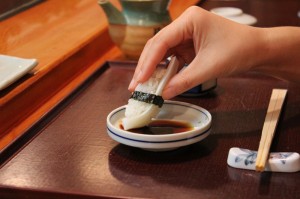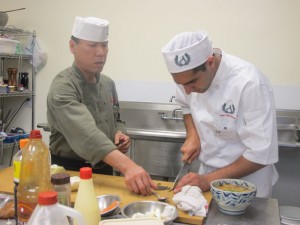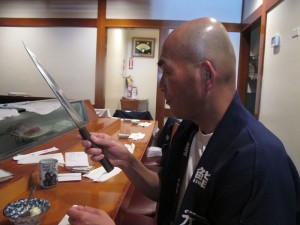(Banner photo © Bill Adams)
How do you evaluate the quality of a sushi restaurant? It’s simple: Sit at the sushi bar. It is ultimately the fastest and best way to learn about sushi and the chef.
While interviewing Japanese sushi chefs in LA, I discovered that they all agree more or less on Mr. Nozawa’s unique translation of omakase as “Trust-Me” has increased the number of orders of omakase. While this seems to show that Americans are more willing to trust sushi chefs, the opposite does not apply. According to most chefs’ point of view, Americans still have a long way to go if they want to be considered “sushi foodies.”
Many Japanese are hesitant to order omakase until they have first made sure of the quality of the food and figured out the price range. Trusting someone takes time and even more so when they come from a different nation, which is likely the case between the Japanese sushi chef and you. Even if you are not interested in becoming a sushi connoisseur, you may at least want to find out what chefs are thinking while they are behind the sushi bar.
One sushi chef and owner, who has had 20 years of experience both in Japan and the US, thinks omakase is a “convenient” and “less troublesome” way to serve arrays of nigiri sushi to Americans. He said he does not want to be told what to do by his customers who don’t know much about sushi because he has carefully thought out and balanced his dishes.
A customer once told him his sushi rice was too warm when it was perfectly made at body temperature. The chef could only guess that the customer was used to eating store-bought and refrigerated sushi. When I asked him if Americans had become more sophisticated sushi eaters in the last 20 years, he did not hesitate to say “No.”
Sushi: Fad or Fealty?
Andy Matsuda from the Sushi Chef Institute thinks sushi has became a “fashion and healthy alternative diet” for Americans. It has only been over the last ten years, both in Japan and the US, that anyone can learn how to make sushi in culinary schools. At the schools it takes only two months to learn the basics of sushi making as opposed to traditional training in Japan which takes years of apprenticeship.
When I asked him if Americans had become more sophisticated sushi eaters in the last 20 years, he did not hesitate to say “No.”
Is sushi culture in the US more about style and fashion than a food to adore for its minimalist artistry and subtle yet sensational taste? This may be true if we measure the population of sushi devotees by the number of people who sit at sushi bars. When compared to Japan, there are far less people at the sushi bar and very few restaurants focused on serving sushi from the sushi bar.
Do Americans not take sushi seriously? Or is it perhaps the Japanese who are too serious? In either case, knowledge of a little sushi etiquette can go a long way.
Sushi Bar Etiquette
Although many Japanese sushi chefs hope Americans can learn more sushi etiquette, most chefs feel awkward about correcting their customers’ table manners knowing many of them may get offended. Depending on the personality of the chef, some might have a long list of disgraceful sushi eating habits.
Here are the top three tips that will help you win over sushi chefs:
1. Keep it together.
Eat your sushi in one bite. A piece of nigiri sushi is formed to integrate both seasoned rice and sliced fish together so taking a piece apart, biting it off or slicing it with chopsticks can hurt a chef’s feelings.
2. Dip the fish side into soy sauce (use your hand at a sushi bar)
Legendary sushi chef Jiro Ono, whose documentary “Jiro Dream of Sushi” got featured at the Tribecca Film Festival, used to say he pressed sushi extra hard for foreigners because they dip the rice side into soy sauce as opposed to dipping the fish side into soy sauce. Kazuhiko Shimizu from Sushi Gen presses rice differently according to how a customer eats sushi. Harder for a chopsticks user and softer for a hand user. He suggests eating by hand especially if you are sitting at a sushi bar. I definitely prefer eating by hand as I love to feel the softly held rice quickly dissipate in my mouth. It is one of the luxuries of eating at the sushi bar.
3. Never order a bowl of rice with nigiri sushi.
Andy from the Sushi Chef Institute once explained that this practice is as weird as ordering a sandwich and additional pieces of bread together.
It is not easy to learn about Japanese food culture. However, by learning more, you will get respect from your sushi chefs. After all, if they are asking you to trust them, don’t you want them to trust you in return? It is up to the Americans to take action.



How to Eat Sushi http://bit.ly/qs7cSM from @toquemag | Give these tips a try during your next #datenight